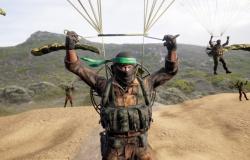A call from cabin crew caused the incident
This in-flight incident story could be called “More Fear Than Harm.” On September 6, 2023, after departure from Brisbane (Queensland) and as it approached its cruising altitude, the crew of a Virgin Australia Boeing 737-800, registered VH-YQR, received a call from the cabin crew asking him to enter the cockpit. The aircraft captain, who was the monitoring pilot (PM), reached across the center aisle to activate the flight deck door switch.
A rolling and yaw motion
Immediately thereafter, the aircraft appeared to momentarily enter a roll and/or yaw motion, which attracted the attention of the crew but, as nothing unusual was apparent, the captain edge continued to hold the switch selection while watching the door and waiting for it to open. After approximately 5 seconds, the aircraft began to roll to the left. The co-pilot, who was the pilot flying, unsuccessfully attempted to correct the roll using the autopilot, then applied significant manual roll correction to return the wings to level while the captain released the switch. The aircraft’s bank angle reached a maximum of approximately 42° left bank and the bank angle alert was activated.
A switch selection error…
Clearly, the captain inadvertently activated the left rudder trim when he wanted to activate the cockpit door switch, which caused a loss of control in flight and a minor injury to one member of the cabin crew, according to an ATSB investigation report. The incident occurred as the plane was approaching its cruising altitude for a flight between Brisbane and Melbourne in September 2023, when the flight crew received a call from a cabin crew member asking to enter the cockpit.
…Operated without looking
After completing the safety procedures, the captain, who was monitoring the pilot, visually identified the flight deck door switch and then reached out to activate it. “While reaching for the switch, the captain looked up from the switch toward the flight deck door, then inadvertently grabbed and activated the rudder trim control,” a said ATSB Chief Commissioner Angus Mitchell.
Similar buttons
The two switches are similar in their operation and are located close to each other on the flight deck aisle panel, between the two pilots’ seats. Initially, the autopilot countered the increased left rudder trim, which resulted in left yaw and left roll, by an opposing and increasing action of the right aileron in bottom of the wing. However, after approximately five seconds of full left rudder trim, the autopilot reached the limit of its ability to counteract it, and the aircraft began to bank increasingly to the left. Identifying the uncommanded and increasing roll and left turn, the co-pilot, who was at the controls, attempted to counter the turn – first with heading mode, which had no effect, then by disconnecting the autopilot and manually applying almost total right aileron input to counter and then correct the left roll.
Countering induced roll
“After regaining control of the aircraft and the crew began to analyze the situation, the pilot in command had to maintain a movement of the stick of approximately 35° towards the bottom of the right wing to counter the roll induced by the action on the steering trim,” said Angus Mitchell. During this troubleshooting operation, the pilot checked the rudder trim indicator, identified the inadvertently applied trim, and applied right rudder trim to override the rudder position.
42° tilt angle to the left
The aircraft’s bank angle peaked at approximately 42° to the left, triggering a Ground Proximity Warning System (GPWS) bank angle alert, and a crew member cabin was slightly injured while stabilizing a catering cart. The plane continued on its way to Melbourne without further incident. As a result of the incident, Virgin Australia changed its cockpit door entry procedures, limiting the time the door unlock switch was held. She also informed the crews of the event and modified her soft skills program accordingly.
“Make sure the order is correct”
“When selecting and activating a control or switch, it is essential that the crew ensures that the intended control or switch is correctly identified and that it is actually selected before ‘be activated,’ commented Angus Mitchell. “Furthermore, it is important that any such incidents are reported to the operator and subsequently to the manufacturer, as continued recording of such events may indicate a design error that needs to be corrected.





